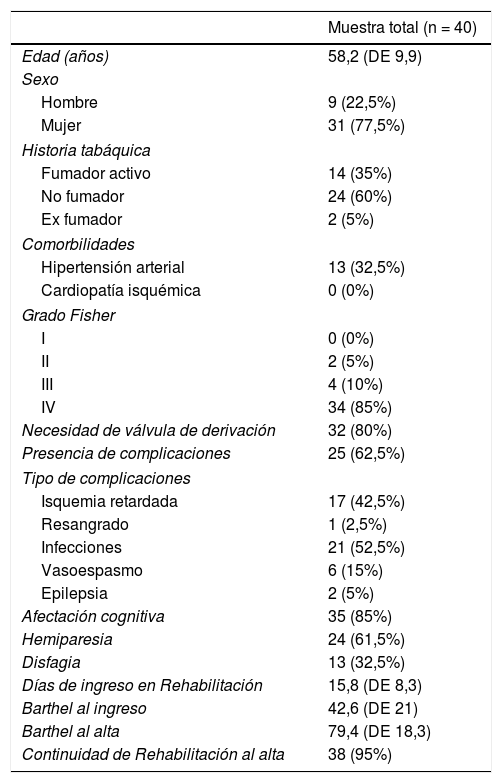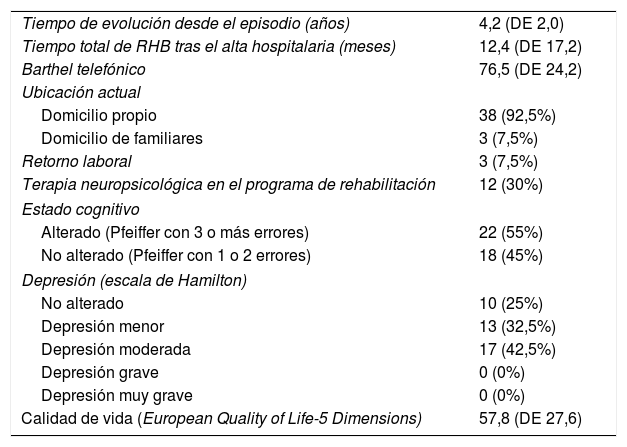Existe poca información sobre los resultados funcionales y cognitivos a largo plazo en pacientes con hemorragia subaracnoidea aneurismática (HSA). El objetivo principal fue evaluar la situación cognitiva, funcional, anímica y la calidad de vida en personas con HSA a largo plazo.
Pacientes y métodoEstudio de corte transversal de una cohorte de 40 pacientes (edad media 58,2 [DE 9,9] años) con HSA ingresados en la unidad de Rehabilitación neurológica entre enero del 2010 a julio del 2017. Variables de resultado: estado cognitivo (cuestionario de Pfeiffer), nivel funcional (índice de Barthel), depresión (escala de Hamilton) y calidad de vida (European Quality of Life-5 Dimensions [EQ-5D]), así como las terapias de rehabilitación realizadas en un seguimiento mínimo de seis meses post-HSA.
ResultadosDe 35 pacientes con alteraciones cognitivas en fase aguda, solo 12 realizaron terapia cognitiva tras el alta hospitalaria. En el seguimiento a largo plazo, los déficits cognitivos persistían en 22 casos, y en comparación con el resto, presentaban peores puntuaciones en el índice de Barthel (15,5 [IC 95% 1,2 a 29,7]), la escala de Hamilton (-0,8 [IC 95% -1,27 a -0,37]), y la EQ-5D (27,6 [IC 95% 12,4 a 19]).
ConclusiónLa prevalencia de déficits cognitivos a largo plazo en supervivientes de una HSA es alta y su presencia se relaciona con un peor estado funcional, más depresión y peor calidad de vida. El bajo porcentaje de individuos que realizan terapia cognitiva en su proceso de rehabilitación junto con las repercusiones clínicas observadas apoyan la necesidad de incluir las terapias neurocognitivas en los programas de rehabilitación de las HSA.
Little data is available on long-term functional and cognitive outcomes in patients with aneurysmal subarachnoid hemorrhage (ASH). The main objective of this study was to assess cognition, functional state, mood disorders, and quality of life in patients with SAH at least six months following the ASH.
Patients and methodsCross-sectional study of 40 patients (aged 58.2 [SD 9.9] years) with ASH, discharged from a Neurologic Rehabilitation unit between January 2010 and July 2017. Main outcome variables: functional status (Barthel index), cognition (Pfeiffer questionnaire), depression (Hamilton scale), and health-related quality of life (European Quality of Life-5 Dimensions [EQ-5D]), as well as type and duration of therapeutic rehabilitation procedures after discharge.
ResultsFrom 35 patients with cognitive disorders, only 12 received cognitive therapy at hospital discharge. In the long-term follow-up, cognitive impairment persisted in 22 patients. When compared with those without cognitive impairment, they presented significantly worse mean differences in the Barthel index (15.5 [95% CI: 1.2-29.7]), Hamilton scale (-0.8 [95% CI: -1.27 to -0.37]), and EQ-5D (27.6 [95% CI: 12.4-19]).
ConclusionThe prevalence of long-term cognitive impairments in survivors of a SAH episode is high, and their presence is associated with worse functional status, more depression and worse quality of life. The low percentage of subjects who received cognitive therapies through their recovery process and the clinical implications observed, support the need of including neuropsychological therapies in the rehabilitation programs after an SAH event.









